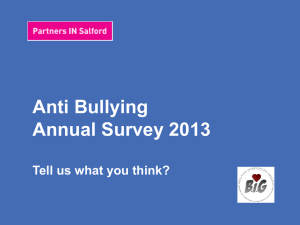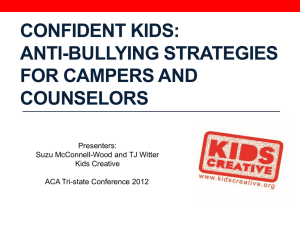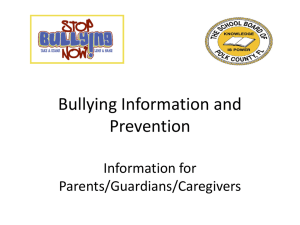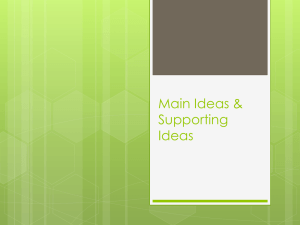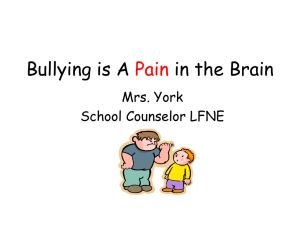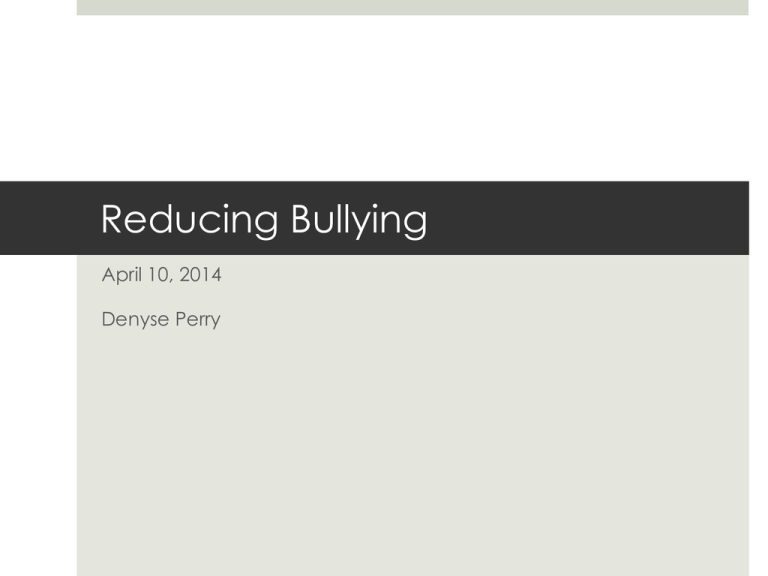
Reducing Bullying
April 10, 2014
Denyse Perry
Afternoon Agenda
1. Understand the problem of “bullying”
Look at the broader system in which aggressive behavior is one
outcome
Expose the brain’s (subversive) role in the system
See aggressive behavior as a result of environmental influences
2. Use this understanding to develop new strategies
Create an intention for what needs to be done
Empathic connection
Practice new tools and skills to support the intention
Conflict occurs when
We think there is only one way or one person to meet a
need
When the strategy chosen to meet a need means that
some other important need will not be met
We need to find ways to meet everyone’s needs
Understanding aggressive behavior
What makes this problem so important?
What is the problem about?
What is the best approach for addressing it?
Key Concepts
Seeing the “bully” through a new lens
A product of his/her environment (biological, relational, cultural)
More than likely acting subconsciously – instinctively, impulsively
A result of chronic stress, adolescent brain adaptation and other
non-intentional factors
Treating the real problem by providing empathic connection,
and support
Replacing punishment and zero tolerance with a desire to
understand, be curious and approach safety as a “protective
use of force”
To make every interaction a nano-shift in this direction
EMPATHY & COMPASSION
Empathy is the ability to see the world as another person, to
share and understand another person’s feelings, needs,
concerns and/or emotional state. Empathy is not agreeing.
Empathy is not sympathy. Sympathy is actually feeling their
pain.
Compassion is empathy with the added desire to help.
The most important change we
can make to reduce bullying
Empathic connection
This afternoon, we learn why …
Ross Greene YouTube
Kids do well if they can.
Ross Greene
The Solution
To address the cause and reduce the problem is in a broad sense to:
Adopt a compassionate attitude when we work with the child
Create an empathic and authentic connection with the child
Ideally facilitate the attachment of the child with a caring and competent
adult
As mentors, develop skills and tools to model healthy and calming interactions
Communication (verbal, nonverbal), word choice
Setting an intention of who we want to “be” in any interaction, even difficult ones
Pausing, breathing
Encouraging release of calming hormone, oxytocin to interrupt or offset flow on
stress hormones cortisol and adrenaline.
Replacing certainty, assumption and judgment with curiosity
What % of your day is dealing with
aggressive behavior?
0-20%
60-70%
20-40%
70-80%
40-50%
80-90%
50-60%
90-100%
What is the physical, emotional and
financial cost?
The physical and emotional cost
How would you rate the stress levels of dealing with this type of
problem on a scale of 1-10 with 10 being the highest stress?
How would you rate the stress of your job overall?
APA finds about 25% of the population experiencing high levels
of stress (8 or >) while another 50% experience moderate levels
(4-7)
This is over and about the 26% of the population that is already
diagnosed with some form of mental illness.
The cost of stress
Chronic mild stress can mean more susceptibility to sickness,
being overweight, difficult sleeping, less sex drive, and
increased risk of more stress
Additional stress is created because access to problem
solving, decision making and social/relational skills is impeded
which creates a cycle of social emotional issues
It’s harder to relate, manage difficulty, focus and sleep
If stress levels are high and chronic, the health risks become
significant …
The cost of high levels of chronic stress
Obesity
Depression
Heart disease
Anxiety
Cancer
Other mental illness
Diabetes
Loneliness
aggression
Estrangement
Discomfort
Separateness
Law Enforcement Marriage
“We all know that the divorce rate for the nation sits right at
about 50%, but did you know that the rate for officers is 60-75%?
Staggering numbers when you really consider it. Approximately
one quarter of the officers who are married will still be married to
that same spouse at the end of their careers. One quarter.”
November 3, 2013
LAW ENFORCEMENT TODAY
The effects are far reaching
It is a serious problem to us
What about our kids:
Effect on the child at the other end of the behavior
Effect on the witnesses – very high
Effect on the child who is behaving in a bullying way
What happened? What can be
done?
What makes the problem so
important?
2013 copyright Sarah Peyton
Characteristics of the Bully
Impulsive
Dominant
Aggressive
Easily make friends (are not loners)
To family members and
peers
Popular
Anger management
Comfortable with violence
Socially adept (may be cold and subtly
manipulative)
Hold in-group/out-group mentality
A form of control and attention
Lacking skills & tools;
Asking for love, attention
and support,
Lack of adult modeling
Lack of understanding of
behavior
28
2013 copyright Sarah Peyton
Family Characteristics of Bullies
Lack of warmth and emotional
support
Poor moods
Lack of parental and family
support
Bullying of siblings
Rigid enforcement of rules
Use of threats and bribes
Maltreatment by a parent
Use of humiliation
Lack of supervision
Violence – nearly twice as
likely to have been exposed
to domestic violence
Inconsistent and corporal
punishment
Negative family functioning
Uninvolved parents
29
Bullying Video
Bully Richard Gale
Interview (Bully of Casey
Heynes)
https://www.youtube.com
/watch?v=__IjcLVBBYc
Causes of Bullying
Negative family function
Too much control by parents
Abuse
Neglect
Sibling bullying
Being bullied
On rare occasion a genetic predisposition
Kids don’t believe they’ll get help
In a survey of American middle and high school students, “66
percent of victims of bullying believed school professionals
responded poorly to the bullying problems that they observed.”
Other reasons the kids gave for not telling include:
Feeling shame at not being able to stand up for themselves
Fearing they would not be believed
Not wanting to worry their parents
Having no confidence that anything would change as a result
Thinking their parents’ or teacher’s advice would make the
problem worse
Heartbreaking that children are not only experiencing bullying,
but don’t trust the reaction of the adults around them enough to
get help
Help for the aggressive child
Children who are bullied are not finding the reactions from their
parents. Children who bully are also not finding help.
Some schools have zero tolerance for bullying. Children get sent
home for bullying, but no support to change the behavior.
Other times when children bully, adults around them don’t know
what to do.
In attempt to name the behavior as wrong, the child may
perceive themselves as also wrong.
Children are labeled “the bully” and those around them have a
static impressions of whether or not the child can truly change
behavior.
A focus only on the harm experienced by child who was bullied
does not create space for the child who is bullying to hope that
their needs will be acknowledged.
1. Where it all began – the lizard brain
The Evolution of the Brain
The brain evolved from the
stem of the spine out and up.
The amygdala is the control
center for the primitive, and
still dominant, fight/flight
impulse.
The newest, most
sophisticated, executive
functioning part of the human
brain is the prefrontal cortex
(PFC) behind the forehead.
Primitive brain = Survival Instinct
Amygdala constantly seeks threat
primary function is survival
Fight/flight/freeze response activated when
“triggered”
Stress hormones cortisol & adrenaline are
released preparing body for action
responds to physical or emotional threat or
an important unmet need
Doesn’t distinguish between fantasy or
reality
Activation of the F/F/F cuts off access to the
PFC and with this the ability to problem
solve, make decisions, regulate emotions
and perform other executive functions.
Prefrontal Cortex
Integrates:
Me - self
You – empathy
We - relational
The purpose of adolescent brain development is to integrate
the brain
To link different areas of the brain to allow more sophisticated
functions to emerge (so the whole is better than the sum of its
parts)
How? During adolescence the brain is remodeling
Pruning (what you don’t use) so it can specialize
Myelination for efficiency – also disciplined practice
Limbic region
Where emotions come from
Motivation – should I bother doing this thing?
Evaluation – how to get this process turned on so the student
will pay attention
Memory
Attachment – our mammalian capacity to have a child
dependent on the parent for survival
Adolescents have emotional spark
Effect of stress on behavior
Stress
hormones
Amygdala
Executive
Functioning
PFC
The 2 basic states of the brain
Reactive or receptive
NO or yes
Can’t learn or communicate optimally if you are threatened
Can’t engage in a supporting, connecting
Fight, flight, freeze or faint (vasil vagal response)
Temperate (genetic) or attachment (experiential) determines
the response
We are in Social-Engagement
when we
Make eye contact
Vocalize with an appealing inflection and rhythm
Display contingent facial expressions
Modulate the middle-ear muscles to distinguish the human
voice from background sounds more efficiently
41
2013 copyright Sarah Peyton
We are in Fight or Flight when
We are afraid or angry
We have an increase in heart rate, blood pressure, respiration,
muscle tone
We want to take action to protect, defend or get away
42
2013 copyright Sarah Peyton
We are in Freeze when
We no longer want to move (fall in energy)
Our heart rate, blood pressure, respiration and muscle
tone decrease
Eyelids droop (not in sleepiness)
Voice loses inflection
Positive facial expressions dwindle
Awareness of the sound of the human voice becomes less
acute
Sensitivity to other’s social engagement behaviors
decreases
43
The impact of chronic activation of
stress hormones
Biologically the threat response is meant for occasional activation.
Physical exertion balances the physiological changes and normal
functioning is maintained.
Most threat is emotional with no physical exertion which is not
considered normal by the body and results in:
High blood pressure, digestive problems, sleep problems, weight
problems
Anxiety, depression, memory & concentration impairment, aggression,
fatigue
Impact of long term stress on Children
(video URL https://www.youtube.com/watch?v=ak7o9nxpWD4)
Rewiring the brain - Neuroplasticity
Neuroscientists now know that our brains are plastic and changing
throughout our lives.
They also know that we humans, by virtue of having a cortex, have the
ability to influence neural structure, thinking, choices, habits and behavior.
This is called neuroplasticity and it has been proven true in altering
conditions from depression, anxiety, aggression, stress and conflict
management.
There is an interpersonal component as well with evidence the brain is wired
to interact socially and attune to one another.
Stroking premature babies for 10 minutes a day promotes brain
development. The brain responds to touch, attachment, connection.
What % of decisions are conscious?
0-20%
20-40%
40-60%
60-80%
80-90%
90-100%
We create our own reality
Brain prioritizes efficiency:
- Habits
- Judgment
- Assumptions
- Labels
Our brains create our stories
subconsciously and retells
them over and over again,
tweaking as convenient,
without our approval.
We have two Hemispheres
48
2013 copyright Sarah Peyton
Right prefrontal cortex qualities: (and
qualities that counteract bullying)
Regulation of body systems
Attuned communication
Emotional balance
Calming the amygdala (modulating fear)
Response flexibility
Empathy
Intuition
Morality
49
The Hemispheres Have Different
Tasks:
Left:
Right:
Narrow focus, the known
Uncertainty, newness, broad scope
Is in charge of approach and speaking in
conversation
Is in charge of listening and the non-verbal,
making space for the other
Other people are tools
Tracks details
Builds categories
Can discern and differentiate
Makes patterns from the specific
Understands emotion and the soul, the
individual
The new, the novel, the specific
Attends to the big picture
Metaphor and poetry
50
Divided brain
Left narrow focus to detail (finding seeds, known), right is broad (unknown, change,
connection)
Frontal lobe is to stop immediacy, stand back, outwitting the other party (Machiavellian)
and also to empathize and make bonds, is uniquely human
Right hemisphere is newer, understanding, disposition for living,
Not reason or imagination, need both hemispheres
Started long ago to drift to left hemisphere, very convincing, controlling
The right hemisphere does not have a voice
Knowledge of parts and wisdom of whole
Rationality grounded in intuition
Need to return to right hemisphere, the intuitive mind is sacred
“The intuitive mind is a sacred gift and the rational mind is a faithful servant. We have created
a society that honors the servant and has forgotten the gift.”
Your brain is just another organ. It is not you.
Build skills in becoming aware of the thinking
that is not working for you.
52
Brain effects of bullying
53
Effects of Bullying
Reduces volume in the PFC where we:
Interpret our social world, process our emotional responses, perceive meaning and
language and where we self-express
Teens – being ostracized by one’s peers can throw adolescent hormones
even further out of whack, lead to reduced connectivity in the brain, and
even sabotage the growth of new neurons.
Limbic region – memory is compromised
Corpus callosum damage
The researchers found that the more exposure to peer verbal abuse subjects
reported, the more likely they were to be experiencing anxiety, depression, anger,
hostility, dissociation, or drug use – effects that can be linked to damage to the
corpus callosum.
PTSD
2013 copyright Sarah Peyton
PTSD
In the short-term, bullied children show cognitive damage
and a tendency toward poor school performance. In the
long term, cumulative brain trauma can lead, some
psychiatrists to diagnose Post Traumatic Stress Disorder
(PTSD) in adults, depending on the severity and duration
of the childhood bullying. This is a crucial insight–just as
we know physical abuse by adults creates lasting damage
in children, it’s becoming clearer that verbal or emotional
abuse by a child’s peers is enough to create lasting,
measurable damage in a child even as she or he grows
older.
55
Cortisol - Quote
cortisol may, in fact, underlie many of the adverse effects
of bullying: It can weaken the functioning of the immune
system, and at high levels can damage and even kill
neurons in the hippocampus, potentially leading to
memory problems that could make academics more
difficult. Indeed, Vaillancourt has already found that teens
who are bullied perform worse on tests of verbal
memory than their peers. One of her next studies
involves trying to get at this question directly: She will be
putting some of her subjects, now ages 16 and 17, into an
MRI machine to look for evidence of damage to the
hippocampus.
56
2013 copyright Sarah Peyton
Effects of corpus callosum damage
The researchers found that the more exposure to peer verbal
abuse subjects reported, the more likely they were to be
experiencing anxiety, depression, anger, hostility, dissociation,
or drug use – effects that can be linked to damage to the corpus
callosum.
57
Things adults should know about the
brain
The idea that “it’s genetic” and brain function is permanent is
untrue:
Temperament and outlook is genetic – and alterable
Most of what we do is habit
The brain is able to change throughout our lives with intention and
practice (neuroplasticity)
The brain has 2 states; reactive or receptive
Interact from a “yes” if you want to be received
Rewiring the brain - Neuroplasticity
Neuroscientists now know that our brains are plastic and changing
throughout our lives.
They also know that we humans, by virtue of having a cortex, have the
ability to influence neural structure, thinking, choices, habits and behavior.
This is called neuroplasticity and it has been proven true in altering
conditions from depression, anxiety, aggression, stress and conflict
management.
There is an interpersonal component as well with evidence the brain is wired
to interact socially and attune to one another.
Stroking premature babies for 10 minutes a day promotes brain
development. The brain responds to touch, attachment, connection.
What to expect from our kids
courtesy of the adolescent brain
Sensitive – over-reactive
Bored one minute – taking risks the next
Hyper rational thinking means they really do know the risks
Extremely drawn to peers and fitting in
The adolescent brain
Emotional spark from active limbic region
Trigger quickly but recover in 90 seconds
Impulsivity in early teens
Social engagement for peer connection
Peer pressure and influence is enormous
But primed for collaboration (more important than IQ in life)
Novelty for preparation of independence
Dopamine draws to pleasure
2 things happen with dopamine
base line is much lower which means more prone to boredom
Release level is higher which encourages risk taking
Hyper rational thinking - imbalanced
Hyper Rational thinking - Risk Taking:
What to do about it
“I’m trying to be like everyone else whose trying not to be like anyone
else”.
To access Neural networks around the heart and the intestines/gut
(through the vassal nerve)
Heart-felt sense and gut-feeling are real - this allows self awareness
This is important because it gives access to internal compass – to positive
values that draws on intuition
When emotions say “I think I’ll drive 90 mph through town.” Don’t say don’t
do it, it’s dangerous”. They’ll do opposite.
Get them to ask themselves “what am I looking for here?” emotions say
“this is so exciting, low risk of death. Let’s do it!”
Pause, build the skill to say “I am aware of a feeling in my heart that tells
me this doesn’t feel right - an intuition. My emotions say it’s good, my gut
says it’s not right.
Mental Illness begins at early
adolescence
Major psychiatric disorders have onset at adolescence 12-24
Because of pruning process
if you are genetically vulnerable or if you have had trauma
your brain is set up with an insufficient number of neurons
Pruning process means half neurons are lost
Brain Function Summary
Subconscious impulse and instinct drive thinking and behavior:
The brain is on alert and under stress far more than is normal with
significant negative, immediate and long term physiological and
emotional health impact
Habit and automation dominate decision making
We are biologically driven to assume, judge, blame, evaluate, and
label. We look for difference and we see the problem.
Objectivity, conscious thought and the ability to manage
behavior is only possible with purposeful activation of the PFC.
Where is the control? Where is the intention?
What just happened?
What is the truth?
Basketball video
Number of throws?
Did you see the lady?
Video url:
https://www.youtube.com/watch?v=nkn3wRyb9Bk
Dan Siegel – the Adolescent Brain
YouTube url:
https://www.youtube.com/watch?v=kH-BO1rJXbQ
Please listen from 1:00 on
Gut feeling and intuition …
Bullying is a complex system of
interdependent factors
Aggressive Behavior
Focus of change
Factor
Actions
Stress
Managing stress
Lack of attachment
Reattaching
Communication/conflict skills
Parental aggression/abuse
Building communication
and conflict skills
Nourishment
Providing food
The teen brain
Embracing teen brain
School climate
Engaging in climate efforts
Afternoon Agenda
Part 1:
A deeper understanding of the system contributing to aggression
brain biology
Relationships
Societal/cultural influences
An understanding of unmet needs
Part 2:
Creating compassionate connection and understanding by:
Creating an intention of how to interact with every child
Interrupting the trigger within the adult and the child
Listening and acknowledging objectively and empathically
Identifying unmet needs
Requesting present positive action
Marshall Rosenberg Youtube
Every action is an attempt to
meet a need.
Marshall Rosenberg
The Summary – The root of Bullying
Behavior
The root of the cause likely has to do with one or all of the following:
Ineffective anger/stress management skills
Environmental factors (relational, social, cultural) that have impacted
the biology of the child
Relational factors include familial experiences (abuse, neglect, poor
modeling, sibling bullying), peers or experiences with people in the
community (police)
Social or cultural factors including media influences
Biological factors tracing to natural brain function (threat response) as
well as neurological damage/alterations from chronic stress due to the
factors listed above
Lack of “attachment” with a caring and competent adult resulting in a
defendedness against adult trust, counter-will, peer orientation
The cause may seem to be intentional bad behavior but science and
research indicate the more likely explanation is defensive instinct and
impulse due to chronic emotional stress and lack of skills and tools
Unmet Needs are
at the center of Relational Conflict
-
Safety, financial security
Attachment
Love & belonging
Food, Rest
Self-worth, meaning
Being valued
Connection to others
Autonomy, independence,
Having choices
Having control
Trust, respect
Understanding
Validation
Individuality
Solitude …
Attachment
Attachment is our mammalian capacity to have a child
dependent on the parent for survival
We need attachment until the day we die
Limbic region genetically programmed to push away at
adolescence to prepare for independence
We attach to peers instead; we need them to survive; we feel
being and
The importance of attachment
Its not about earning – every child needs to be attached
to at least one caring and competent adult
Kids need a home base – someone to provide a place
of retreat – just knowing –
Evokes the desire to be good for those attached to
Children have instincts to be good and bad, threat or
reward – just like us
What is your intention?
Are you ready to give empathy in every situation? Isolate the
behaviors that may not have been as intentional as they seem?
Unconditional positive regard? Dignity? Respect? Compassion?
Summary
Address the problem in order to stop it:
Create adult connections for kids who have none
Replace punishment and judgment with empathy, support
and compassionate guidance
Replace zero tolerance with “the protective use of force” (a
nonviolent communication expression)
Model compassionate communication and conflict
resolution
Use natural tools available to each of us at any time:
Release oxytocin, say “yes”, be curious
Compassionate Communication
in Difficult Situations
The Tools
What is your intention?
I will hold this as my intention in any interaction,
particularly with any child, regardless of circumstance:
Tools
Use “yes” as much as possible
Make a no, a “yes, no, yes”. Yes to something important,
no to the request (“and I can’t let you do this”), yes to
something else.
Curiosity helps understanding much better than
assumption, judgment and labeling
Achieving Connection through Empathic
Understanding
Goal = Make a Connection. Always connect first.
Phase 1 – Preparation
1) Set an Intention – how do you want to “be” in the world?
2) Become self-aware – notice the thinking and events that
cause you to trigger
3) Practice pausing – as a first response to the “trigger”
(breathe, smile, yawn, touch)
Connect
Phase 2 – Connecting
1) Remember your intention – expect it
will be forgotten when you need it most
2) Invite your connection – smile, say
name, greet
In person
Electronically as well – email
Empathic Support
Phase 3 – Giving Empathic Support
1) Listen with full presence – listening is not
waiting to speak
2) Acknowledge with empathy – reflect back
what you heard, with a feeling if possible
3) Help identify the unmet need – help discover
the source of their feelings or discomfort
4) Request the opportunity to provide support –
ask how you can help
Requests
Phase 4 – Making requests
1) Share an observation – a neutral expression of what is
affecting you
2) Share your feeling – if this is appropriate. If not, simply name
it to yourself
3) State your need – share what this is about for you (value,
wish, dream, want)
4) Make a request – say what you are hoping for in a doable,
concrete and present form
Interrupting a Trigger
be curious
remember your intention
slow your speech
breathe
ask for a pause
Activity: Know thy “trigger”
What does the trigger signal?
____________________________________________________
Why is that important?
____________________________________________________
What does your trigger feel like in you?
____________________________________________________
How can you use the trigger to your advantage?
____________________________________________________
Resources
Kids do well if they can – Ross Greene, child psychologist,
author of “Lost at School”
Every action is an attempt to fulfill a need – Marshall
Rosenberg, author/founder of “Nonviolent
communication” (NVC)
Hold on to your kids – Gordon Neufeld, adolescent
development specialist, author of “Hold on to your Kids”


